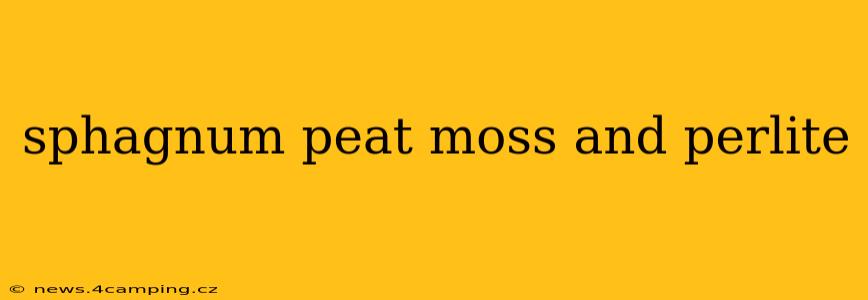Sphagnum Peat Moss and Perlite: The Dynamic Duo for Potting Mixes
Sphagnum peat moss and perlite are two incredibly popular components of countless potting mixes, each bringing unique and essential properties to the table. Understanding their individual roles and how they work together is key to creating a thriving growing environment for your plants. This article will delve into the specifics of each material, exploring their benefits, drawbacks, and ideal applications. We'll also address some frequently asked questions surrounding their use.
What is Sphagnum Peat Moss?
Sphagnum peat moss originates from partially decayed sphagnum moss, a type of moss found in bogs and wetlands. It's a lightweight, highly absorbent material with excellent water retention capabilities. This makes it an ideal component for potting mixes, as it helps to keep the soil consistently moist without becoming waterlogged. Its slightly acidic pH also benefits many plants that prefer acidic conditions, such as blueberries, azaleas, and rhododendrons.
Benefits of Sphagnum Peat Moss:
- Excellent water retention: Keeps the soil moist without becoming soggy.
- Good aeration: Allows for sufficient oxygen flow to plant roots.
- Lightweight: Easy to handle and transport.
- Acidic pH: Beneficial for acid-loving plants.
- Sterile: Generally free from diseases and pests.
Drawbacks of Sphagnum Peat Moss:
- Can become compacted: Over time, it can lose its structure and become dense.
- Environmental concerns: Harvesting peat moss can contribute to habitat destruction. Look for sustainably harvested peat moss to minimize this impact.
- Nutrient-poor: Doesn't provide significant nutrients to plants.
What is Perlite?
Perlite is a volcanic glass that has been heated to a high temperature, causing it to expand into a lightweight, porous material. This expansion creates a multitude of tiny air pockets, making it an excellent amendment for improving soil drainage and aeration. Perlite doesn't retain water like peat moss, instead allowing excess water to drain freely, preventing root rot.
Benefits of Perlite:
- Excellent drainage: Prevents waterlogging and root rot.
- Improved aeration: Increases oxygen flow to plant roots.
- Lightweight: Easy to handle and transport.
- Inert: Doesn't affect the soil pH.
- Sterile: Free from diseases and pests.
Drawbacks of Perlite:
- Doesn't retain water: Needs to be combined with a water-retentive material like peat moss.
- Can be dusty: Can cause irritation during handling.
How Sphagnum Peat Moss and Perlite Work Together
The combination of sphagnum peat moss and perlite creates a near-perfect potting mix for many plants. The peat moss provides water retention and helps hold nutrients, while the perlite ensures proper drainage and aeration, preventing root rot. This balance is crucial for healthy plant growth. The ratio of peat moss to perlite can vary depending on the specific plant's needs and the overall mix's intended purpose. Generally, a mix of 50/50 or a slight leaning towards peat moss is a good starting point.
What are the best uses for a Sphagnum Peat Moss and Perlite mix?
A sphagnum peat moss and perlite mix is ideal for a wide range of plants, including:
- Seed Starting: The airy mix allows for excellent germination.
- Seedlings: Provides consistent moisture and aeration for young plants.
- Cuttings: Helps to root cuttings effectively.
- Acid-loving plants: The slightly acidic pH of the peat moss is beneficial.
- Houseplants: Creates a well-draining and moisture-retentive potting mix.
Is Sphagnum Peat Moss and Perlite Better Than Other Potting Mixes?
There's no single "best" potting mix. The ideal mix depends on the specific needs of your plants. However, a blend of sphagnum peat moss and perlite often offers a good balance of water retention and drainage, making it a versatile and popular choice for many growers. Other options, such as coco coir, are also excellent alternatives and are often chosen by those concerned about the environmental impact of peat harvesting.
Can I use Sphagnum Peat Moss and Perlite for all plants?
While the sphagnum peat moss and perlite mix is suitable for many plants, some prefer different growing conditions. For example, succulents and cacti might require a much more porous mix with less peat moss. Always research the specific needs of your plants before preparing a potting mix.
Where can I buy Sphagnum Peat Moss and Perlite?
Sphagnum peat moss and perlite are readily available at most garden centers, nurseries, and online retailers.
By understanding the individual properties of sphagnum peat moss and perlite and their synergistic effects when combined, you can create the ideal growing medium to nurture your plants and help them thrive. Remember to always consider the specific needs of your plants when choosing a potting mix.
